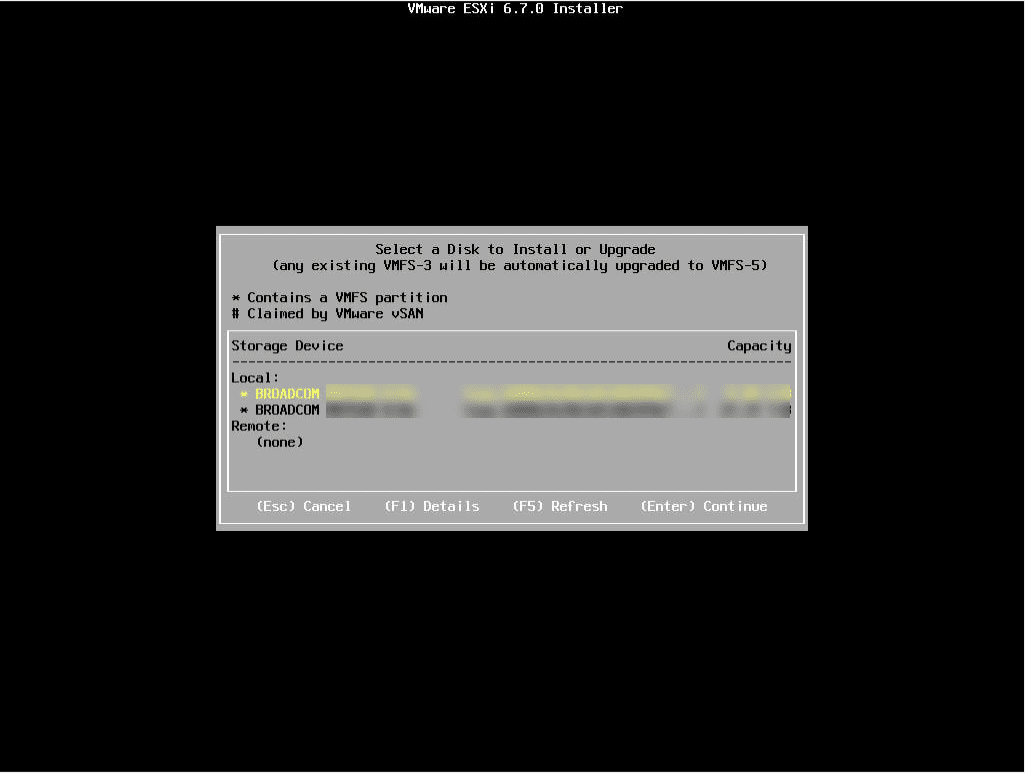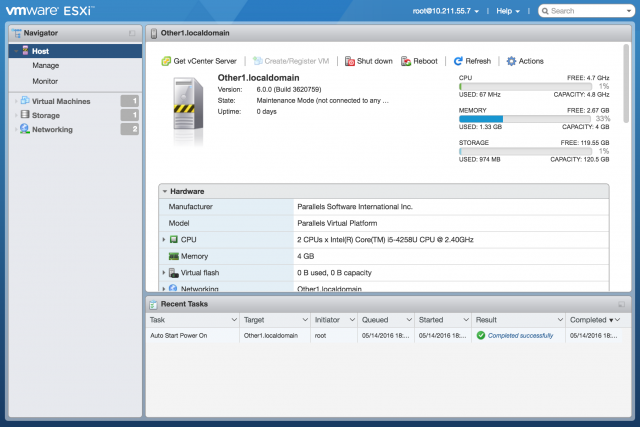

- #INSTALL OS X ON ESXI MAC OS X#
- #INSTALL OS X ON ESXI INSTALL#
- #INSTALL OS X ON ESXI LICENSE#
- #INSTALL OS X ON ESXI ISO#
- #INSTALL OS X ON ESXI DOWNLOAD#
But as mentioned earlier, allocate enough resources to this virtual machine. If your VMware workstation did not detect the correct ESXi version as 7.x, then select any of the older OS types as below.ģ) I will not cover each step in creating a new virtual machine in VMware. If not, enable it in BIOS and confirm that the host Operating System is sensing it.įind out more information about enabling vt-x in BIOS.Ģ) Create a new virtual machine in VMware.


Make sure that you have a VT supported processor and it is enabled in the BIOS. Note : Once done it should have created a file called Sierra.iso on your desktop.NOTE: Since I assume you will be doing this setup on the latest computer which supports hardware virtualization technology, I do not need to emphasise that here.
#INSTALL OS X ON ESXI ISO#
# Rename the Sierra ISO Image and move it to the desktop Hdiutil convert /tmp/ -format UDTO -o /tmp/Sierra.iso Hdiutil convert /tmp/ -format UDTO -o /tmp/ElCapitan.iso # Convert the Sierra ISO Image to ISO/CD master (Optional) Hdiutil detach /Volumes/OS\ X\ Base\ System/ Rm /Volumes/OS\ X\ Base\ System/System/Installation/Packages cp -rp /Volumes/install_app/Packages /Volumes/OS\ X\ Base\ System/System/Installation/Ĭp -rp /Volumes/install_app/BaseSystem.chunklist /Volumes/OS\ X\ Base\ System/BaseSystem.chunklist cp -rp /Volumes/install_app/BaseSystem.dmg /Volumes/OS\ X\ Base\ System/BaseSystem.dmg # Remove Package link and replace with actual files # Restore the Base System into the Sierra Blank ISO ImageĪsr restore -source /Volumes/install_app/BaseSystem.dmg -target /Volumes/install_build -noprompt -noverify -erase Hdiutil attach /tmp/ -noverify -nobrowse -mountpoint /Volumes/install_build Hdiutil create -o /tmp/Sierra.cdr -size 7316m -layout SPUD -fs HFS+J # Create the Sierra Blank ISO Image of 7316mb with a Single Partition – Apple Partition Map Hdiutil attach /Applications/Install\ macOS\ Sierra.app/Contents/SharedSupport/InstallESD.dmg -noverify -nobrowse -mountpoint /Volumes/install_app Open the terminal and run the below command one after another. Once downloaded, minimize or close the installer.
#INSTALL OS X ON ESXI DOWNLOAD#
Note, you need a Genuine Mac machine in order to download and convert the Sierra installation disk. Grab the Sierra installer app from the Apple App Store.
#INSTALL OS X ON ESXI INSTALL#
esxi-install.sh in order to install the Unlocker. Create a new folder (mkdir) called tools and transfer your unlockerXXX directory.Ĥ.Now cd into the uploaded directory and ensure the ESXi scripts have execute permissions by running chmod +x esxi-install.sh. Once connected navigate to /vmfs/volumes/datastore/, replacing datastore with your actual datastore name. Make sure you extract the files somewhere on your client before transfer and connect to the ESXi host using the user root. Click Start and then close all the open dialogs.ģ.Transfer the Unlocker-files to the host using any SFTP client. The dialog Services Properties should appear and from here you can click on SSH->Options and choose Start and Stop with host. From here click on Properties in the upper right corner where it says Services. In order to do that, login to the host using VMware vSphere Client and navigate to Configuration->Security Profile. You will need to register on the site in order to download the Unlocker tool.Ģ.You need to enable SSH server service on your ESXi host. So, the first thing you need to do is to customise the hypervisor layer by executing an Unlocker script by. VMware ESXi 6.0 doesn’t support OS X out of the box.
#INSTALL OS X ON ESXI MAC OS X#
Before deployment, you must read EULA for Apple Mac OS X license, given link at the end of this HOWTO.ġ. In this HOWTO, provided the steps to create an Mac OS X 10.9 Mavericks as a VM in ESXi 6.0 Host for a test case scenario. Mac OS X 10.5 Leopard Server, 10.6 Snow Leopard Server, 10.7 Lion client or server, 10.8 Mountain Lion client or server and 10.9 Mavericks client or server are fully supported on VMware Fusion while running on supported Apple hardware.
#INSTALL OS X ON ESXI LICENSE#
The End User License Agreement (EULA) for Apple Mac OS X legally and explicitly binds the installation and running of the operating system to Apple-labeled computers only. According to Apple licensing policies, VMware only supports the virtualization of Apple Mac OS X 10.10 (Yosemite) client or server, Apple Mac OS X 10.11 (El Capitan) client or server, Mac OS X 10.9 (Mavericks) client or server, Mac OS X 10.8 (Mountain Lion) client or server, Mac OS X 10.7 (Lion) client or server, 10.6 (Snow Leopard) server and 10.5 (Leopard) server. We all know VMWare start to supporting Mac OS X as VM on latest ESXi hypervisor releases.


 0 kommentar(er)
0 kommentar(er)
